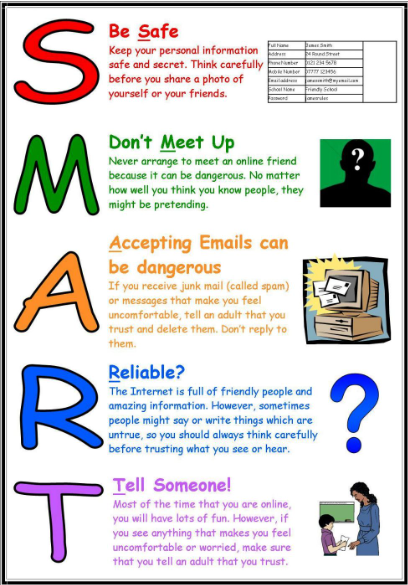Keeping Children Safe Online
 |
Online safety is a vitally important part of modern education and modern life. At Wheatcroft, we teach children how to stay safe online and regularly work with families to pass along key tips and messages. Each year the whole school takes part in Internet Safety Day. |
The online world is a rapidly changing landscape, and we aim to teach children the values and behaviours that will allow them to be safe regardless of technological developments. These include:
- how to use technology safely, respectfully and responsibly;
- how to recognise acceptable/unacceptable behaviour;
- how to identify a range of ways to report concerns about content and contact
If you’re uncertain or worried about how to support your child with technology, then speak to us!
Alternatively, you might find your question answered in the advice below or weblinks.
Using the Internet safely
|
The Internet is a fantastic source of fun e learning, but it's worth following some simple rules to help your children stay safe online.
|
 |
Children and social media
Nearly all social networking sites such as Facebook, Twitter, Snapchat, Instagram, Musical.ly and Skype have a minimum age of 13 to access and use their services. Whatsapp now has a minimum age of 16.
As an adult, you should consider carefully the impact of anything you share on your own social media about your child. For example, could your post identify them to strangers or compromise their safety.
Apps on smartphones and tablets
 |
Many children now use apps on smartphones and tablets. Some of these devices have a child mode that stop children leaving the app they are using and accessing other things accidentally. Some apps have 'in-app purchases' that require a payment to get extra features or progress in the game. Some devices have parental controls that require a password to be entered before a purchase can be made. If your device has these features, consider turning them on. |
Top Tips
- Prioritise safety - Teach children not to give out personal information. This includes their name, address, and telephone number. Other details about their life can give away more information than they might think. Children should avoid posting which school they go to or uploading pictures of themselves in their uniform.
- Set parental controls - Work together with your child to agree a list of websites they can visit. Remember to check the minimum age limit on services like Facebook, Tik Tok and YouTube. Most social media channels have an age limit of 13.
- Be open - Let them know that they can tell you about anything that happens on the internet. Try to listen without judgement or anger. With older children, explain your worries so they can see the reasoning behind any rules you set.
- Location - Think about locating your computer in a supervised, family area to help you oversee what your child is accessing. Despite parental controls which you may have in place, unfortunately sometimes children can be exposed to unwanted and unpleasant comment content.
- Discuss their activity - Take an interest in their online world. Talk to them about their favourite websites, videos, and their online friends. This will keep communication open between you and your child.
- Set boundaries - Establish time limits for activities such as using the internet and gaming. Make sure to set aside time for 'unplugged' family activities.
Useful Links
Parental Controls on Games Consoles
Parental controls for iPhone iPad & iPod
Parental controls offered by your home internet provider
Online Safety Guide for Parents and Carers
https://www.nspcc.org.uk/keeping-children-safe/online-safety/
https://saferinternet.org.uk/guide-and-resource/parents-and-carers
